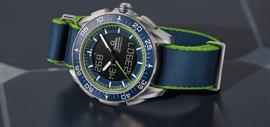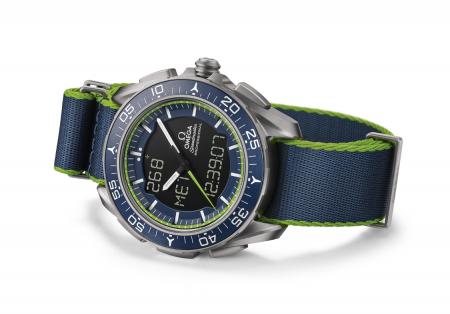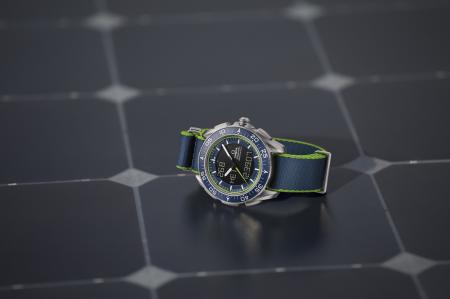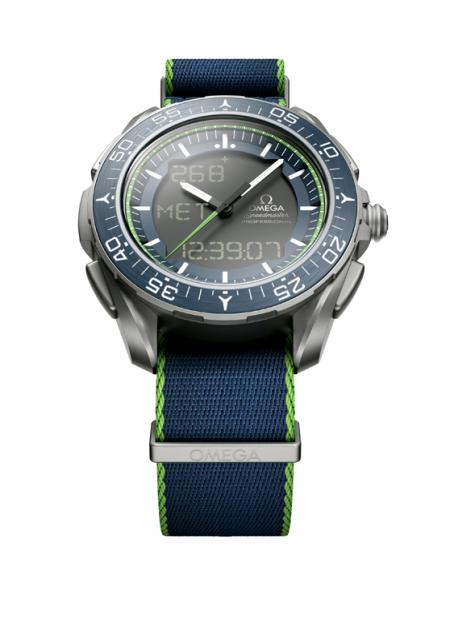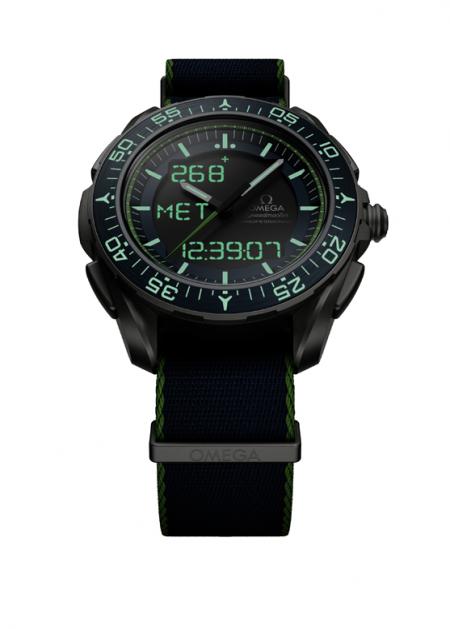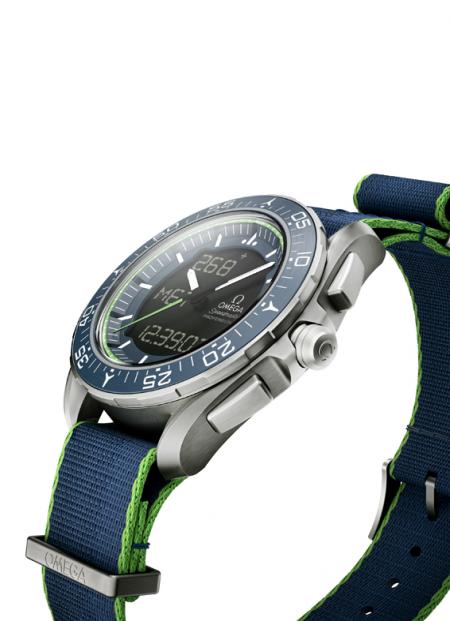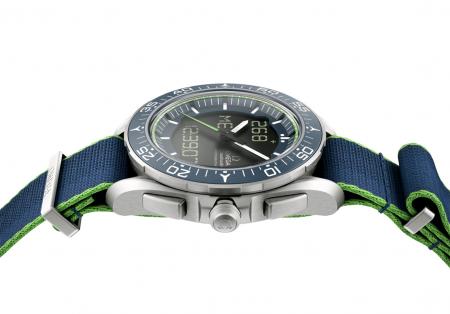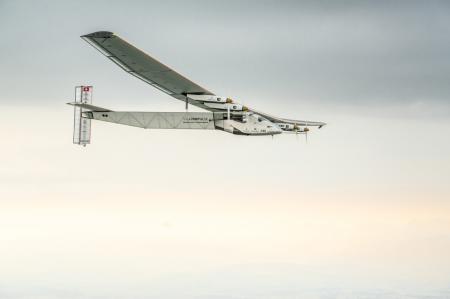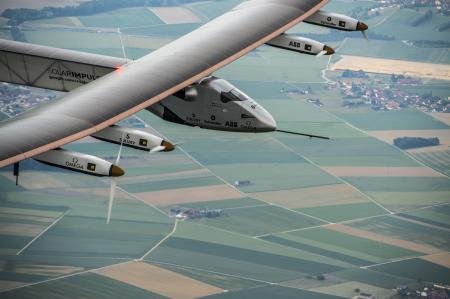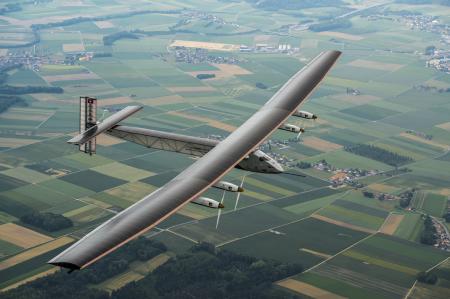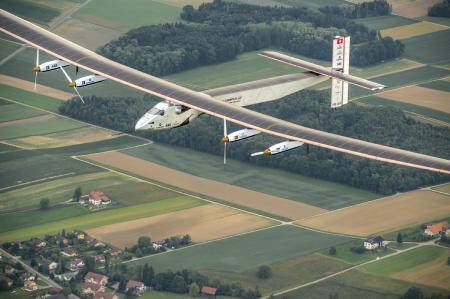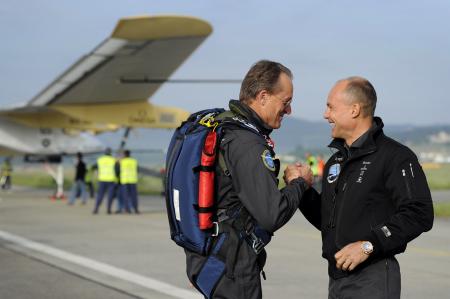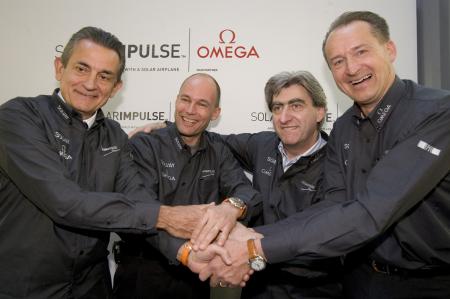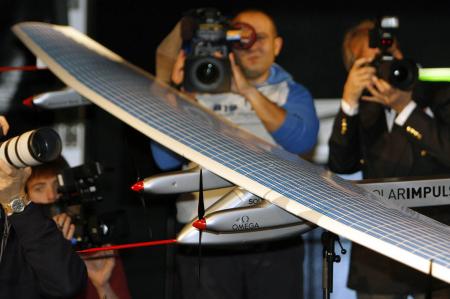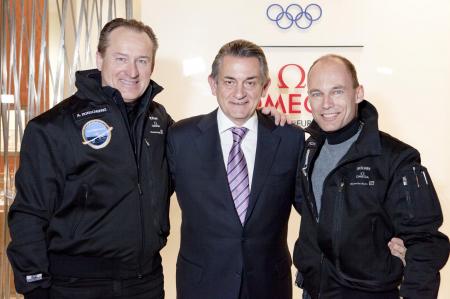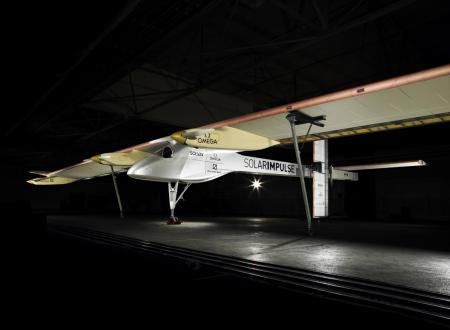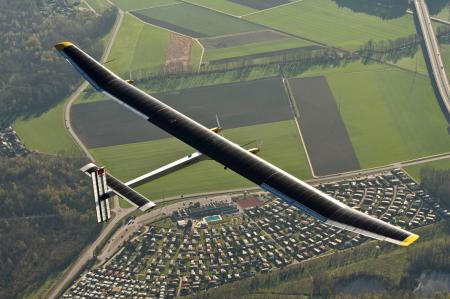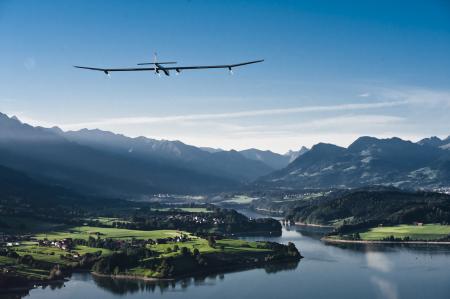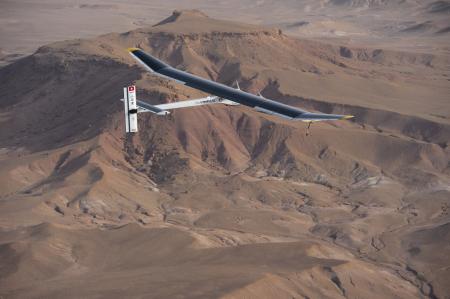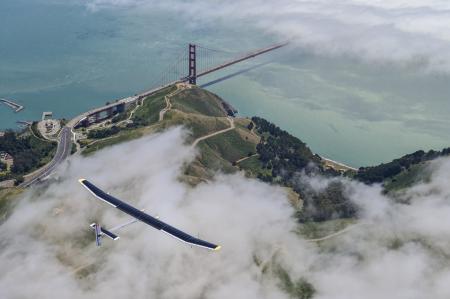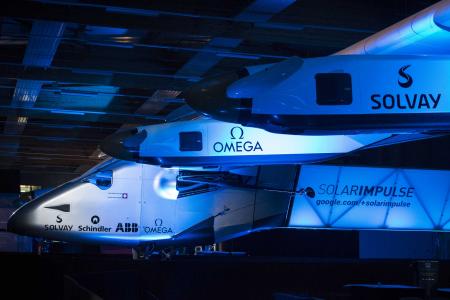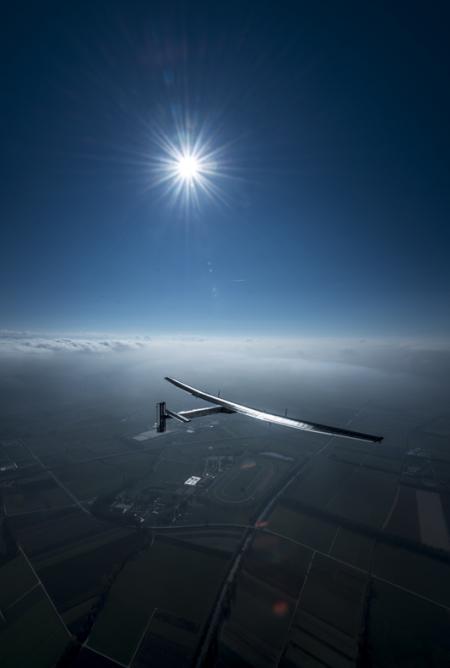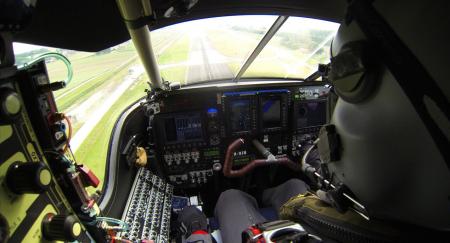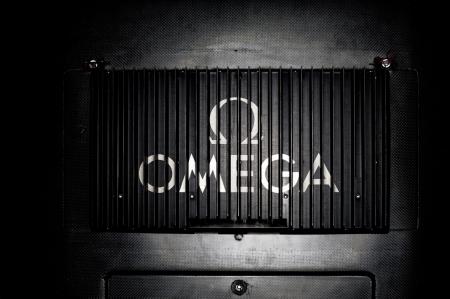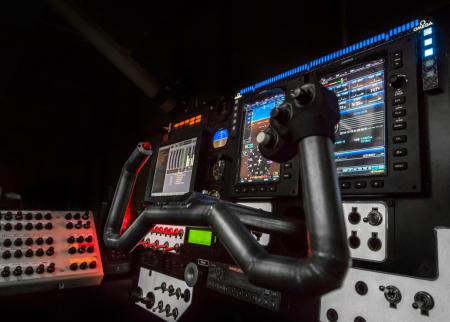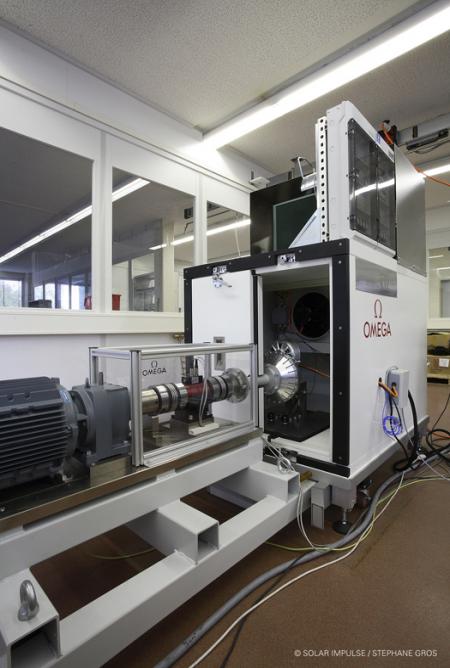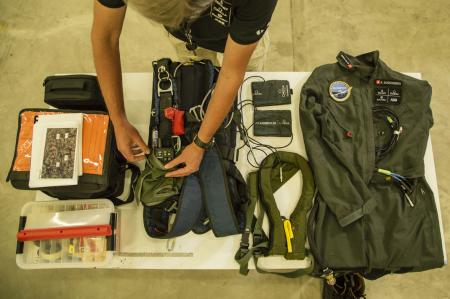New Omega Speedmaster Solar Impulse
Just in time for Solar Impulse’s long awaited round-the-world journey, Omega is proud to unveil the latest addition to its legendary Speedmaster family: the Speedmaster Skywalker X-33 Solar Impulse Limited Edition.
More than a remarkable timepiece, the Speedmaster Skywalker X-33 Solar Impulse Limited Edition is a celebration of a project whose ambitious aim is to circle the globe in an airplane powered only by solar energy, making a bold statement about viable alternatives to non-renewable energy.
Crafted from lightweight grade 2 titanium, the 45 mm brushed case features a blue ceramic bezel coated with white Super-luminova. The blue and green dial, with its white transferred indexes and Super-luminova-coated hour markers, has a central opening allowing the wearer to read the liquid crystal display digital elements (grey on a black background) such as the hour, minute and seconds of up to three different time zones, three alarms, chronograph and countdown functions, and a perpetual calendar with day, date, month, year and week number indications.
Skeletonised black and white hour and minute hands are coated with Super-luminova which emits a green light. The black and green central seconds hand is clearly visible. The hands can be disengaged to allow clear reading of the digital display.
The Omega Speedmaster Skywalker X-33 Solar Impulse Limited Edition is powered by the multi-functional quartz chronograph movement, Omega calibre 5619, with a thermo-compensated integrated circuit. in addition to its analogue and digital displays, this timepiece has two functions that will prove useful for the pilots: mission elapsed time (MET) and phase elapsed time (PET).
The grade 2 titanium outer caseback is secured with eight screws and is stamped with the Solar Impulse “Around the World” patch and engraved with the name of the timepiece as well as the words “TESTED AND QUALIFIED BY ESA” (the European Space Agency).
Affirming its reliability, precision and ability to withstand challenging environments, this new X-33 model has been tested and qualified by the ESA and was developed under an ESA patent license based on an invention by ESA astronaut Jean-françois Clervoy.
Presented on a blue and green-bordered polyamide “NATO” strap, this timepiece will be produced in an edition limited to 1,924 pieces. The number honours the year that the first round-the-world flight took place; members of the united States Army Air Service flew around the world from 4 April to 28 September 1924.
Solar Impulse and Omega : Past, Present and Future
Below are the milestones that have paved the way to the round-the-world adventure in 2015.
2003 – Solar Impulse initiator, chairman and pilot Betrand Piccard presents the idea of a solar-powered airplane to the École polytechnique fédérale de lausanne, which agrees to do a feasibility study whose leadership was entrusted to engineer and professional pilot André Borschberg. later that year, on 28 november, the project was officially launched.
2006 – Omega becomes a main partner of the Solar Impulse project following a particularly moving and convincing presentation Piccard prepared for Swatch Group chairman nicolas G. Hayek and Swatch Group CEO Nick Hayek.
2007 – A prototype of the HB-SIA plane is unveiled at a special event attended by Nicolas G. Hayek and Nick Hayek Jr. At the event, Omega presents its first contribution to the Solar Impulse project: the test bench. This important testing system enables the Solar Impulse team to simulate the plane’s electrical system.
2008 – Omega presents a special Solar Impulse exhibit at the Omega pavilion at the Beijing 2008 Olympic Games where the brand is serving as official Timekeeper. The exhibit includes a virtual display of the pilot’s controls and a large-scale model of HB-SIA.
2009 – HB-SIA, the first aircraft designed to fly both day and night without fossil fuel, is unveiled on 26 June. This plane has a wingspan of a Boeing 747-400, weighs 1700 kilograms, and has more than 12,000 solar cells mounted on its wings to supply renewable energy to four electric motors.
2010 – Solar Impulse test pilot markus Scherdel begins the test flights of HB-SIA. on 7 July, Solar Impulse co-founder and ceo André Borschberg completes the first night flight in the history of solar aviation. The pilots’ flights mark the first time that two new Omega technologies are used: the vibrating sleeves and the Omega instrument, which was created by former ESA astronaut Claude Nicollier, the head of Solar Impulse’s flight test operations. A couple months after the first night flight, the aircraft is flown across Switzerland.
2012 – HB-SIA completes its first intercontinental flight when it is flown over the mediterranean sea from Payerne, Switzerland to Morocco. The voyage was divided into seven legs.
2013 – Solar Impulse makes its way across the united States of America, flying from San Francisco to New York City with stops in Phoenix, Dallas, St. Louis and Washington D.C.
2014 – Solar Impulse 2 (HB-SIB or Si2) is presented to the public in April. Abu Dhabi is selected as the host city for the next phase of the Solar Impulse project: the 2015 round-the-world flight.
2015 – In March, the round-the-world Solar Impulse flight will take off from Abu Dhabi and over five months the pilots will stop in Asia, North America and Southern Europe, flying day and night, to complete the first solar-powered circumnavigation of the world.
Omega’s contributions
Omega has made use of its international platform to share the successes of the Solar Impulse project with the world. Beyond broadcasting the historic milestones and achievements that have highlighted the journey to the Solar Impulse 2’s round-the-world journey, Omega has also contributed a number of important technological innovations to help the whole Solar Impulse team achieve its goals.
Lightweight landing lights system
The lightweight landing lights system ensures that the pilot’s visibility of the landing area is the same at night as it is during the day. The entire system, which includes promotional and landing led lights, the focusing lenses, cables, power transformer and connectors, weighs just one kilogram and has the same energy consumption as a bedside lamp.
Omega instrument
The Omega instrument, designed by ESA astronaut and Solar Impulse head of flight test operation Claude Nicollier, is used to indicate the flight path and alerts the pilots if the angles of the wings exceed a normal limit. The single horizontal light bar indicates the lateral angle while the two shorter vertical light bars show the pilot the bank angle of the wings.
Test Bench
in 2007, Omega provided the Solar Impulse team with the test bench: a system which enabled the team to simulate and optimize the plane’s electric system on the ground before it was integrated in the plane.
Warning systems
Vibrating Sleeves: The sleeves of the pilot suit vibrate to ensure that the pilot will react in a timely fashion to the critical information provided by the instrument. This technology, which resembles the cuffs a doctor places on a patient to test his or her blood pressure, makes use of small knobs whose vibration is enhanced by a soft plastic casing. The vibration is strong enough to wake the pilot from his power nap during a long-distance flight.
Omega Buzz: Omega has also created a special alarm that, when activated by the pilot, emits a loud buzz between 90 to 100 decibels every 20 minutes until he pushes a button to turn the sound off and restart the 20-minute countdown. This alarm ensures that the pilot doesn’t fall asleep during the flight segments where he should remain awake.
DC-DC converter
Solar energy is used to power the instruments in the cockpit through high-voltage batteries in each of the plane’s four gondolas. The DC-DC converter converts the energy from the gondola batteries to a low voltage (28V) so that the plane’s low-power cockpit electronics can also function with energy from the sun. The conversion system in Si2 is lighter, smaller and more efficient than other similar converters available on the market.
Energy dispatcher
HB-SIB is equipped with one energy dispatcher on each wing. The energy dispatchers make use of bi-directional functionality to ensure that either gondola battery can support the other on the same wing in the event that one engine fails. The energy dispatcher transfers the energy that has been produced by the solar cells on the gondola with the failed engine and distributes it to its functioning counterpart so that the plane can continue to fly.
